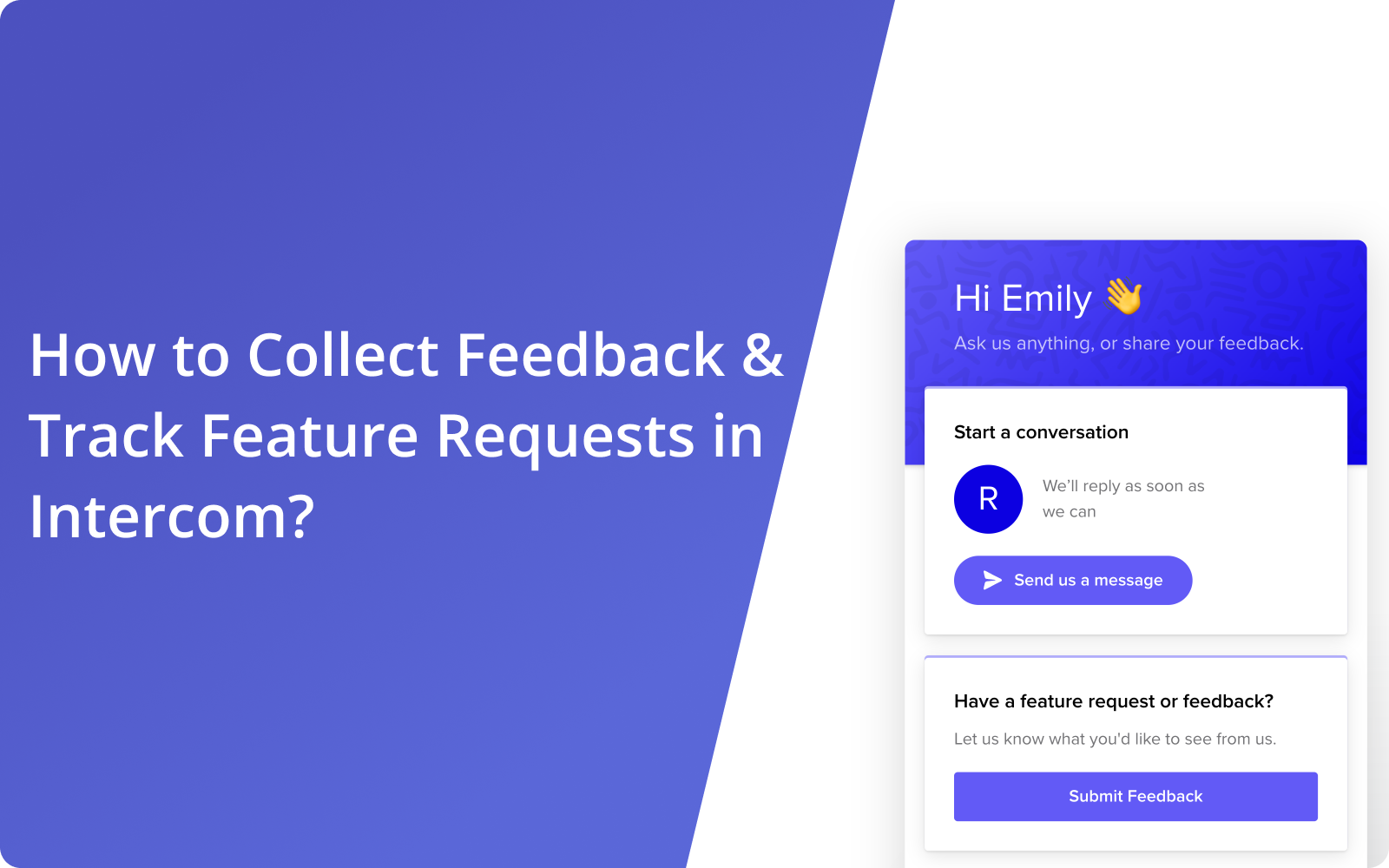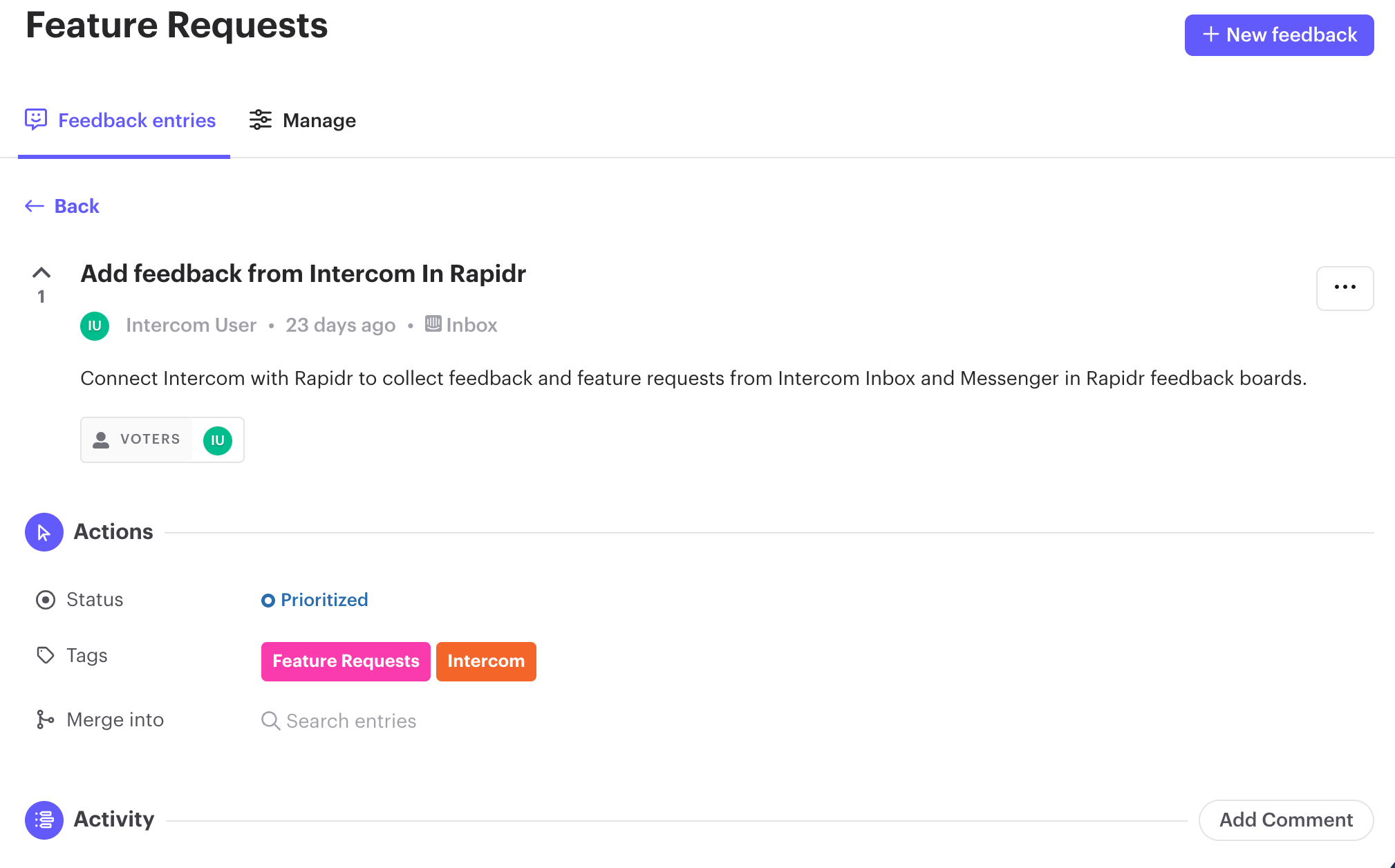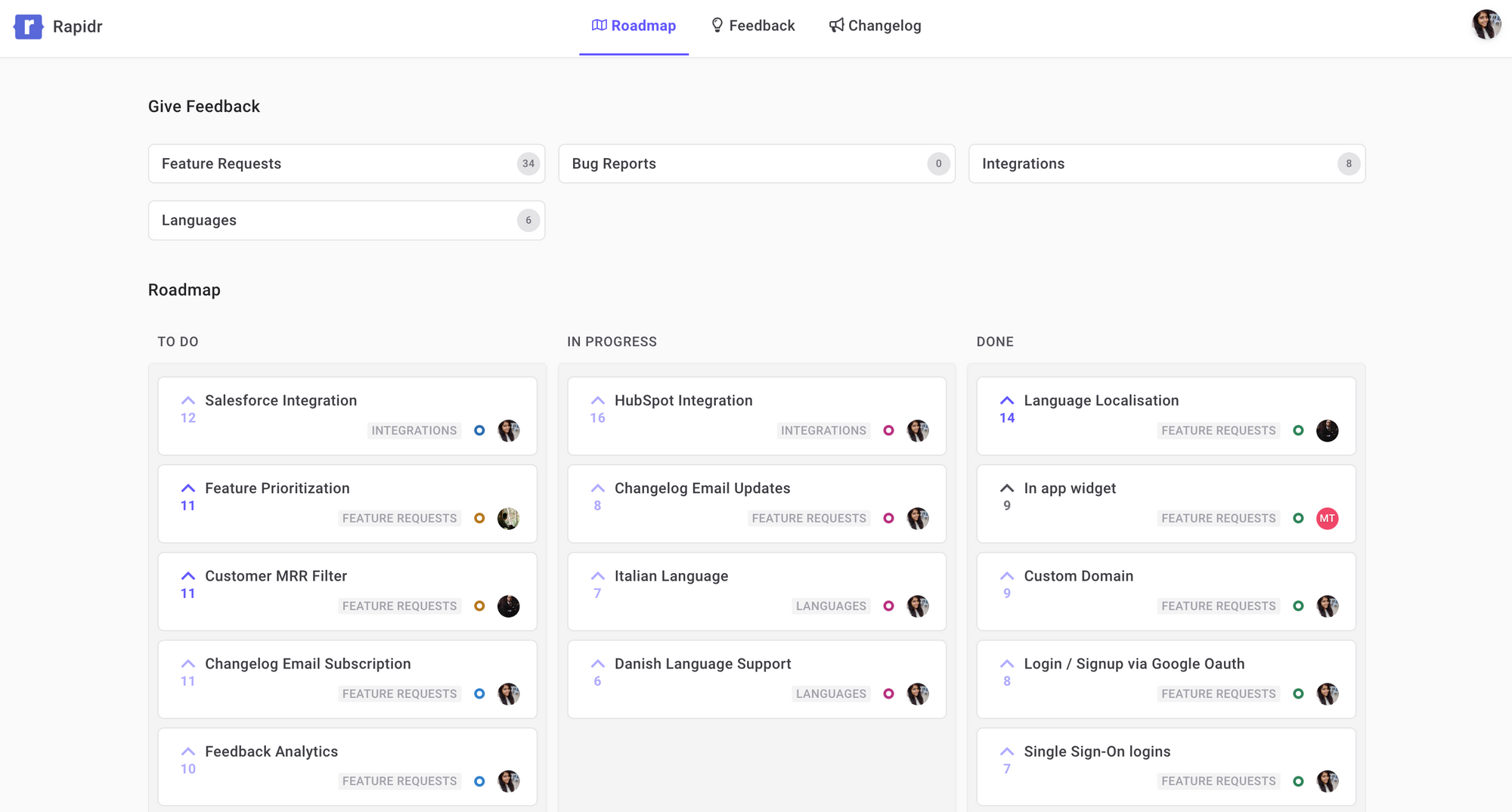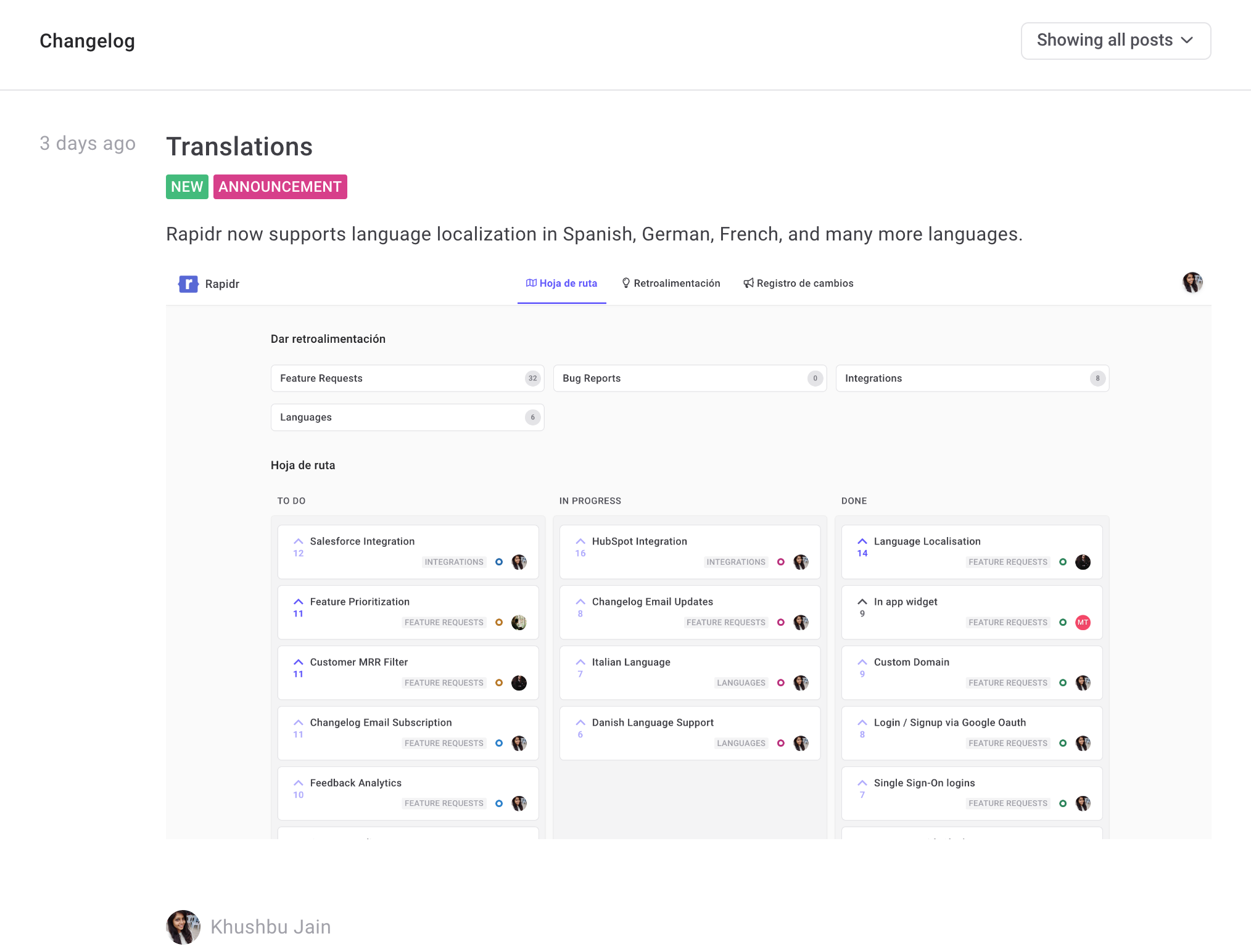
How to Collect Feedback & Track Feature Requests in Intercom
Intercom provides a comprehensive customer communication platform that helps companies build better customer relationships by collecting feedback and feature requests via Inbox and Messenger.
The feedback and feature requests received from customers via Intercom would help inform your product decisions, be more customer-centric, and understand how your customers use your products at a deeper level, paving the way for customer-led growth.
You don’t want to lose this opportunity to use valuable feedback to improve the product. This requires a dedicated system to collect and manage feedback that helps your customers feel heard and involved.

Qualities of a Good Feature Request Tracking System
Simple and Easy to Use
Simple to understand and easy to use. It should also be easy to update and maintain and provide a clear overview of the status of any given request. The process should also be flexible enough to work well with the organization’s culture, size, and scope of work. Help you manage the requests by organizing, categorizing, and prioritizing them.
Supports collaboration between Team and Customers
Allow for easy collaboration with other team members. A system that is easily accessible and visible to the whole company. One that encourages collaboration between customers and teammates to understand customer needs and team limitations better.
Supports Systematic Categorization and Segmentation
The Intercom integration should automatically sync user and company data and attributes from your Intercom workspace, which are used to segment and prioritize feedback from your most valuable customers. It should allow the user to see all of the feedback collected in one place and their status. The user should also be able to filter by different criteria such as date, priority, status, or type and pick out duplicate requests.
Closes the Feedback Loop
The process should also provide transparency to stakeholders about the status of a project or idea. A good feature request process should be able to communicate with users about their requests through email notifications, Slack messages, or any other appropriate channels. It should also show how many of the requested features are already in development, which will help users understand the progress being made.
How to Collect Feedback and Feature Requests in Intercom:
- Using Intercom tagging and reports, it lacks essential features for feedback tracking and requires exporting feedback for management.
- Using generic tools like Spreadsheets or Trello, they have no Intercom Integration, don't support segmentation, and close the feedback loop.
- Using a dedicated feedback management tool with a deep Intercom Integration like Rapidr.
Rapidr's deep Intercom Integration makes it easy for your product and customer support teams to track incoming feedback on Intercom. You'll be able to:
- Track customer feedback and feature requests while conversing with the customers in the Intercom Inbox.
- Capture the votes of customers requesting feedback requests already present directly in Inbox to avoid duplication.
- Receive user feedback requests via Intercom Messenger directly on your feedback boards in Rapidr.
- Insert relevant information as cards while replying in Intercom conversations, along with the feedback name and a link to the full feedback post on the Rapidr dashboard.
- Rapidr automatically detects your customer's details and links them to your feedback in the Rapidr dashboard, enhancing your feedback management process.
- Prioritize and analyze feedback to see what's most impactful to inform product decisions in Rapidr.
- Show the progress of the feature development via Public Roadmap in Rapidr.
- Once implemented, inform your customers about releasing requested features via Release Notes in Rapidr.
Capture User Feedback without leaving the Intercom Inbox
Enable your team members to capture feedback or track customers' interest in any existing feedback by adding Rapidr to your Intercom Inbox. Select any conversation inside the Intercom Inbox, and hit "Customize" to add "Rapidr" from the menu.
Rapidr in Intercom Inbox lets your team members create feedback on behalf of the customer and track their vote on any existing feedback.
Here's how it all ties together:
- Search for existing feedback with a few keywords. We try to fetch the most relevant feedback for your search query.
- Alongside feedback, Rapidr shows a few critical pieces of information like "In Progress" and # of votes received so you can communicate that with the customer. Since the feedback provided is already in the system, you can click on the list item (feedback), and their vote will be captured.
- When nothing matches your search result, you can create new feedback on behalf of the customer.
Receive User Feedback via Intercom Messenger
Add the Rapidr app to let users give you feedback directly from Messenger Home. Once done, you can let your users suggest ideas and send feature requests directly from Messenger. It’s one of the easiest and most convenient ways to capture feedback, taking the burden away from your support reps.
Whenever a customer opens the Intercom Messenger, Rapidr will prompt your users if they have a feature request or feedback to share. If they do, they can directly share what's on their minds by clicking a button.
Insert Relevant Information in Intercom Conversations
Your support team can insert relevant information as cards in the conversations when replying with Rapidr. For example, "Your feedback has been tracked" or "Your vote has been added," along with the feedback name and a link to the full post on the Rapidr dashboard. This enables your customer to click through to the Rapidr portal and read comments or browse related feedback.
You'll immediately notice the user interface is almost identical to the Inbox app. The only difference between them is that when you create feedback or track a vote here, we'll create a conversation card and insert it into your current reply.
Here's an example:
As a rule of thumb, Use the "insert into Conversation" feature when you want to send the Rapidr app to your customers to help them click through and interact with the feedback portal. And the Inbox app when you don't like to send them any additional info or don't want them to know what feedback management software you're using.
Identify Top Feedback for Product Improvement with Rapidr
To enable your users or team members to send feedback to Rapidr, you must create at least one feedback board on your Rapidr account. Boards help you categorize and organize feedback and collect feedback via Intercom and through widgets, Slack, Jira, Hubspot, etc.
Use votes and comments within a feedback board to prioritize features and make feedback-driven decisions. Rank feature requests and tasks based on impact to focus only on essential ideas. Keep a clear overview of feedback that matters.

Prioritize and Showcase progress with Product Roadmap
Rapidr helps you create a Public Roadmap. When paired with the existing feedback boards, this roadmap helps you by showing your customers the progress and direction of product development.
This roadmap also helps you communicate your priorities over broad timeframes, emphasizing the near term and assessing new feedback requests for functionality against planned work.

Keep Customers Engaged with Product Updates & Release Notes
Release Notes is the easiest way to keep your customers or prospects informed about what's new with your product. Automatically update users and other stakeholders, don’t leave them wondering what’s come of their feedback.
The final step to closing the feedback loop is communicating and keeping customers in the loop as their feedback moves through the product development process.

Never lose sight of common feature requests, ideas, and pain points from your Intercom conversations with Rapidr. Easily see what matters to your customers and why and inform your product decisions with all contexts at hand.
While many customer feedback management tools help you capture, organize, and prioritize feedback, consider the one that enables you to uncover the insights from the feedback and shape your product strategy.
1. Centralized and organized by category: The first step in solving this is to organize feedback in a central location. You’ll likely receive feedback from various channels and integrations like emails, Slack channels, support inboxes, forms, and in-app widgets.
2. Easily accessible to everyone: Centralizing all feedback data in one place, which can be easily accessed, will ensure that critical feedback doesn’t get lost and will allow you to understand what to prioritize.
3. Shared across internal teams: A central hub lets customer-facing teams access and submit feedback easily. A dedicated system will also help plan regular meetups with teams to discuss customer feedback and determine how to use it to define product strategy.
4. Prioritize and analyze feedback: Prioritize features and rank feature requests and tasks based on impact to make feedback-driven decisions. Remember, it's not just about collecting feedback. The real power lies in analyzing this qualitative data and implementing actionable changes that genuinely reflect your customers' desires and pain points. This ongoing listening, learning, and improving cycle sets successful companies apart.
With Rapidr, you can collect, analyze, and organize feedback and engage with customers as their feedback moves through the development process. Other notable features include collecting feedback via widgets, slicing and dicing feedback, embedding a roadmap into your product, and closing the feedback loop.
Sign up and set up a complete customer feedback management system to boost customer retention and satisfaction.

